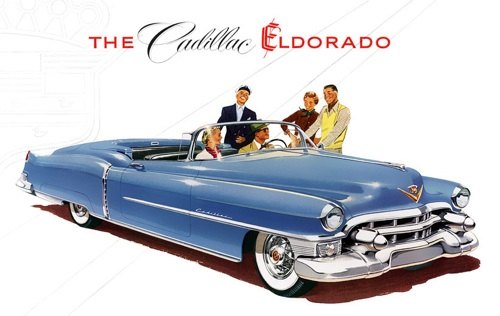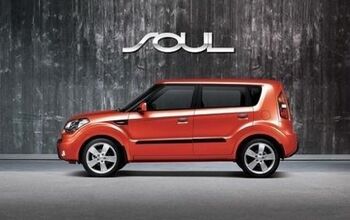Editorial: General Motors Death Watch 249: Cadillac Descending
It doesn’t seem that long ago that General Motors was pouring billions of dollars into Cadillac in a bid to create a line of world-class luxury cars. American enthusiasts rejoiced. Now, with GM on the verge of bankruptcy, all signs point to a full-scale retreat. Assuming GM pulls through, within the next five years it will kill Buick outside China–or at least kill its Lexian aspirations—and shift Cadillac downmarket into a “near luxury” position.
Cadillac’s bid for a return to greatness met with an early success. The 2003 CTS’ angular styling might have polarized opinions, but it made a strong statement and grabbed everyone’s attention. The car’s performance suggested that GM was capable of developing a first-rate rear-wheel-drive sport sedan.
The Escalade sold well, but its pushrod powerplant and antiquated chassis did not fit Cadillac’s new mission. A DOHC-powered, independently suspended crossover would be much more fitting. Problem was, in the late 1990s it was hard to tell what would make for a successful crossover. Should the proportions be those of an SUV, or more like those of a station wagon? Cadillac opted for the latter, while the market opted for the former. Combine wagonesque proportions with a BMW-like price, and the 2004 SRX flopped.
The 2004 XLR roadster was sharply styled, but insufficiently luxurious and (like the SRX) over-priced. Perhaps emboldened by the CTS’ success, Cadillac convinced itself that it could give subsequent models Teutonic prices from the start—a bad move. Both Toyota with the original LS 400 and Hyundai with the Genesis recognized that new entries must start low. If they sell, then you can raise the price. So the XLR became strike two.
The CTS had carved out a spot vis-a-vis the BMW 3-Series. Could a rear-wheel-drive Seville replacement do the same against the 5-Series? First, newly hired car czar Bob Lutz delayed the STS. Not a fan of Cadillac’s new look, he ordered that the STS’ greenhouse be redone to add tumblehome—even though such a major change late in the process cost tens of millions of dollars.
Though perhaps an improvement, the revised design both failed to be beautiful and failed to make a strong statement. The interior, though more luxurious than that of the CTS, was still not luxurious enough for the STS’ richer target market, and its styling was boringly conventional. The market yawned, and stuck with the imports. Strike three.
Hyper-expensive supercharged STS-V and XLR-V variants were little more than a distraction. If the basic product isn’t a winner, adding power isn’t going to make it one.
Lutz’ desire to offer a production version of the gargantuan 13.6-liter Sixteen? To those thinking with their heads, the Sixteen seemed overly ambitious and a poor use of corporate resources. Before it could realistically attempt a statement like the Sixteen, Cadillac first needed to succeed not only with the STS but with a never approved S-Class competitor. In retrospect, this embodiment of the Detroit executive ego seems downright ridiculous.
Back in the real world, Cadillac’s upmarket adventure was dealt a fatal blow when the STS failed to carve out a beachhead north of $50,000. In the aftermath, Cadillac couldn’t decide what to do next. Plans to replace both the STS and DTS with a large rear-wheel-drive luxury sedan wandered this way and that, then died. The V8 that would have powered this car met the same fate. Hyundai could field a competitive DOHC V8. Detroit would not.
Yes, the redesigned 2008 CTS has been a hit and deservedly so. But you can’t base a luxury brand on one $35,000 model.
At the same time, Cadillac can’t simply return to where it used to be. The DTS has solidered on, but sales have slowed to a trickle. With the Zeta-based replacement canceled, and no new large front-wheel-drive platform in the pipeline, Cadillac could simply abandon the large luxury sedan segment. With the collapse of the conventional SUV market, the Escalade also seems unlikely to live on in its current form.
So, whither Cadillac? With the foray into Teutonic territory one for four, and no funds for another round, Cadillac’s target must shift from the Germans to entry-level Lexus. For 2010, the SRX switches to an Equinox-related front-wheel-drive platform. Next up: a LaCrosse-based sedan. After that: perhaps a Lambda-based Escalade.
In short, Cadillac’s new focus will be Buick’s current focus: front-wheel-drive-based, comfort-biased vehicles with transaction prices in the thirties to low forties. If the two aren’t to overlap, Buick will either have to shimmy closer to Chevy or become China-only. Among the many casualties of GM’s meltdown, this forced acceptance of Cadillac’s second-tier status could be the saddest. Even Lincoln, which beat a similar retreat post-Nasser, could emerge with a stronger product line.
Want to remember Cadillac at its final zenith? Buy a 2009 CTS-V.
Michael Karesh lives in West Bloomfield, Michigan, with his wife and three children. In 2003 he received a Ph.D. from the University of Chicago. While in Chicago he worked at the National Opinion Research Center, a leader in the field of survey research. For his doctoral thesis, he spent a year-and-a-half inside an automaker studying how and how well it understood consumers when developing new products. While pursuing the degree he taught consumer behavior and product development at Oakland University. Since 1999, he has contributed auto reviews to Epinions, where he is currently one of two people in charge of the autos section. Since earning the degree he has continued to care for his children (school, gymnastics, tae-kwan-do...) and write reviews for Epinions and, more recently, The Truth About Cars while developing TrueDelta, a vehicle reliability and price comparison site.
More by Michael Karesh
Latest Car Reviews
Read moreLatest Product Reviews
Read moreRecent Comments
- VoGhost Just reminding us all that we have to tolerate dealers (many of whom are billionaires) in the US if we want new legacy ICE vehicles because the dealers pay for the campaigns of local politicians, with our money.
- 1995 SC I'm still trying to get past the fact that the Red Bull guy is married to a Spice Girl.
- Ravenuer Not into F1. Started watching NASCAR back when they raced actual cars. (yeah I'm that old). Not any more. They aren't "stock cars" now. Not even close. Even drag races don't interest me anymore. Races are over in 3 seconds.
- Wjtinfwb No confusion on my end, Ghost. The Government has zero role in job creation outside of the legitimate opportunities' created by Government going about it's responsibilities, namely keeping the American people and territory safe from foreign intrusion. Of course, they're failing epically at that but that's a different topic. The American free enterprise system is what enables job creation. Government's role is to stay out of the way of that system, but they seem incapable of doing so. Oil & Gas exploration is just one example. If a National Job Policy is what you're looking for, there are other countries that will be happy to accept your application for residency.
- Michael Smith I drive 100-300 miles a day in new BMWs, Mercedes-Benzes, and GM SUVs. Some are already equipped with automatic braking.It's the first thing I turn off when I start the car.I've had experiences where (as the author notes) the system gave false alarms and stabbed the brake pedal, threatening my ability to control the car.Further, every driver encounters situations where, for example, legal following distance must be momentarily compromised in order to avoid a difficult situation. When the system intervenes, it disrupts the driver's plan of action. This can lead to a collision as the driver has to suddenly react not to his surroundings, but to the system.Not only is automatic braking an insult to skilled drivers, it's dangerous to everyone.


































Comments
Join the conversation
Hmmmm Mr Karesh... I have to whole-heartedly agree with you on so many levels. I never understood what I believe to be an odd situation. The DTS was front drive. The STS was rear drive. And they both offered a massive wallowing vehicle to sit in (sofa) as they ride down the road. Its amazing, Mr Karesh ya nail it on the head. Then there is the debate about the entry level Caddy, the BLS. I had heard that this car FAILED in EUROPE because there isnt any value in a Cheap American car. But I dont understand the point of the CTS now. This was THE entry car at 35. So is this moving up market, and getting larger? And why are sport versions of this car.. only done in the last gen front and rear clip? Caddy.. as I believe is confused. Ya got the CTS that brings in the-people-who-want-American-or-not-the-3-series. And ya got the Slade and its brethen.. for the thugs who really need... (holds back THOSE comments), or the soccer moms who think its cool to drive around in a overpriced by 25g TAHOE. And at this point.. There isnt much at all that doesnt make them like Saturn or Buick. They have dervatives. Then again.. Buick is even WORSE shape. There is no name recognition except for grandpa, and the designs.. arent polarizing. The names are made up and there isnt enough to hold up a fort. They are trying to go after Lexus, but with MUCH less. Worst part... Buick for China, could probably work here, if they spent a coupla bil on marketing. Cadillac Desending... This is how it starts. Ya get the monster of a boat, up against something immovable.. and slice the right side a good 300' into the ship... And its all over. Face it, at this point.. it leads me to just wonder whats the point of half to three quarters of what they sell.
shaker: I think.. you sir have hit the nail, right on the head. SUVS.. are equated with luxury. Sedans and all else.. arent. I wonder if.. GMs bankruptcy will settle that notion.